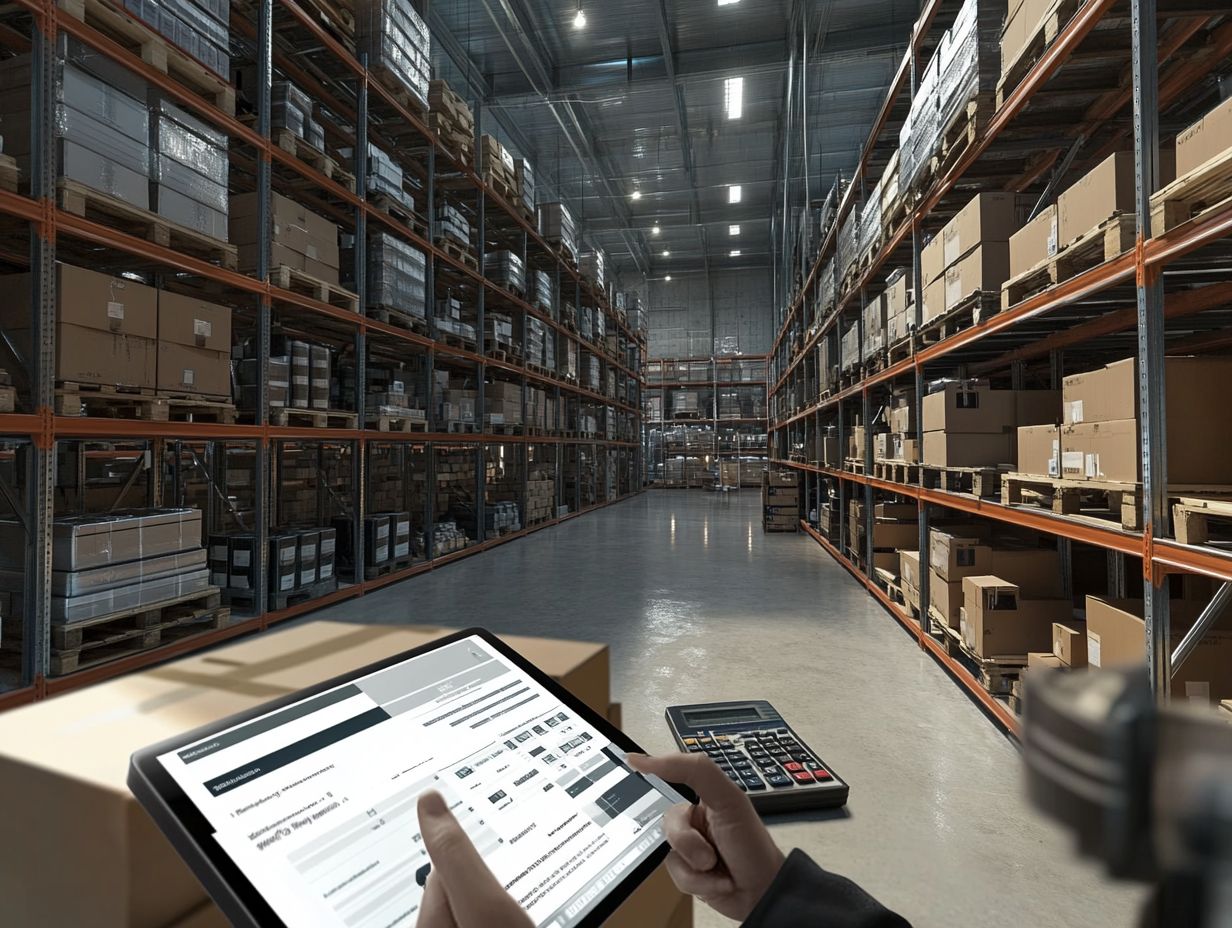Understanding the Costs of Physical Asset Storage
In today’s fast-paced world, efficiently managing physical items is essential for both businesses and individuals. This article explores the complexities of physical asset storage, examining the various types of assets typically stored, along with the direct and indirect costs associated with their storage.
You’ll discover the factors that influence these costs, such as location, accessibility, security, and insurance. The article also presents strategies to enhance efficiency while minimizing expenses. Key considerations for selecting the right storage provider are highlighted.
Whether you re a business owner seeking to streamline operations or someone aiming to optimize personal storage solutions, get ready to unlock essential insights designed just for you!
Contents
- Key Takeaways:
- Types of Physical Assets
- Costs of Physical Asset Storage
- Factors Affecting Storage Costs
- Maximizing Efficiency and Reducing Costs
- Considerations for Choosing a Storage Provider
- Frequently Asked Questions
- What is physical asset storage?
- Why is understanding the costs of physical asset storage important?
- What are the common costs associated with physical asset storage?
- Are there any hidden costs of physical asset storage?
- How can businesses reduce the costs of physical asset storage?
- What are some potential risks of inadequate physical asset storage?
Key Takeaways:

- Physical asset storage includes various items like merchandise, equipment, and documents.
- Storage costs consist of direct expenses like rent and indirect costs such as security and insurance.
- Location, accessibility, and security are key factors affecting physical asset storage costs. Consider these when choosing a storage provider and implementing cost-reduction strategies.
Defining Physical Asset Storage
Defining physical asset storage means understanding the intricacies of managing physical items like machinery, vehicles, and equipment throughout their entire life cycle. Effective physical asset management ensures these essential items are stored and maintained properly, while also being monitored diligently to maximize their availability and value.
This practice is crucial for sectors such as manufacturing, transportation, real estate, and utilities, where optimal asset utilization can dramatically influence operational performance.
Aligning your physical asset storage with comprehensive management strategies will keep you compliant with industry regulations and standards. By implementing advanced asset tracking technologies, which help you keep tabs on your items in real-time, you gain quick access to vital asset information and history.
Regular audits, paired with these technologies, help maintain asset condition and uncover potential vulnerabilities while identifying areas ripe for improvement.
By adopting a proactive approach to asset management, you can elevate your operational performance while ensuring your invaluable resources are well-protected against unforeseen challenges.
Types of Physical Assets
In the realm of physical asset management, you encounter a diverse array of physical items essential across various industries think machinery, vehicles, infrastructure, and energy-related resources. Each category of these items has its own management requirements that significantly impact operational efficiency and the strategies you adopt for utilization, tracking, and maintenance prioritization.
Understanding the nuances of these asset types is vital for implementing effective management practices that enhance organizational efficiency and ensure compliance with safety regulations and industry standards.
Common Types of Assets Stored
Unlocking the full potential of your assets starts with understanding their types. Common physical assets found across various industries include equipment, vehicles, and machinery. Each type requires specific management strategies for optimal performance and longevity.
You ll encounter unique challenges with inventory management, maintenance schedules, and condition monitoring. These challenges call for tailored approaches to asset tracking and risk mitigation.
By managing these assets effectively, you enhance operational capabilities, reduce costs, and improve asset value.
Take equipment like production lines, for instance. They require routine inspections to prevent unexpected breakdowns. Vehicles, on the other hand, need diligent fuel tracking and maintenance to ensure safety and efficiency on the road.
As for machinery, it often requires specialized training for operators to maximize use and lifespan. Effective inventory management practices involve keeping detailed records and utilizing software systems to monitor asset conditions closely, allowing for timely maintenance.
This proactive approach minimizes downtime and fosters a culture of accountability, encouraging employees to be more aware of their roles in asset preservation. However, you should remain vigilant; challenges like fluctuating market demands can complicate your inventory levels, making agility and responsiveness essential for your organization.
Costs of Physical Asset Storage
The costs tied to physical asset storage are complex and can be divided into two main categories: direct and indirect costs. Both play a critical role in shaping your asset management strategies.
Direct costs usually involve expenses for storage facilities, maintenance schedules, and compliance requirements. Indirect costs can include operational inefficiencies and the diminished value of assets from insufficient monitoring and management.
Understanding these costs helps you create better asset management strategies that emphasize both cost-effectiveness and sustainability.
Direct Costs

Direct costs in physical asset storage encompass the explicit expenses associated with managing and maintaining your physical assets, including maintenance, labor, and compliance-related fees. These costs significantly affect the overall financial performance of your asset management strategies.
Managing direct costs effectively helps mitigate maintenance issues and ensures compliance requirements are consistently met. For example, routine maintenance expenses like inspections, repairs, and replacements are critical components to track meticulously.
Labor costs for the staff responsible for these assets can escalate rapidly if not monitored closely. Compliance-related fees may arise from regulatory audits or necessary certifications, highlighting the importance of maintaining detailed records and documentation.
By implementing strategic asset management practices, you can optimize these various elements, potentially reducing costs through predictive maintenance using data to predict when maintenance is needed and efficient labor deployment.
Act now to prevent costly downtime and enhance compliance with regulations while minimizing disruptions.
Indirect Costs
Indirect costs related to physical asset storage include various hidden expenses that arise from poor asset management. These costs can affect your operational performance and overall asset value. You may see them as lost productivity, downtime from equipment failures, or expenses from insufficient employee training on using and maintaining assets effectively.
It s vital to recognize and address these indirect costs to enhance accountability measures and ensure the longevity of your assets.
Indirect costs can also manifest as increased energy consumption, poor inventory control, and financial burdens from regulatory compliance related to asset oversight. For instance, without proper inventory tracking, you might face overstocking or stockouts, leading to wasted resources or missed sales opportunities. Additionally, understanding the liquidity of physical assets is crucial in managing these costs effectively.
By training your personnel to manage assets effectively, you can significantly mitigate these risks. This not only boosts operational efficiency but also fosters a culture of proactive risk management. Investing in comprehensive training programs helps align your asset management strategies with your overall business objectives, promoting a healthier bottom line and improving the resilience of your assets.
Factors Affecting Storage Costs
Several critical factors impact your storage costs for physical assets. These include location, accessibility, security measures, and insurance requirements.
The geographical placement of storage facilities greatly influences your logistics and operational efficiency. The level of security and the type of insurance you choose also affect both cost-effectiveness and risk management strategies.
By understanding these elements, you can optimize your asset management processes and ensure compliance with relevant regulations.
Location and Accessibility
The location and accessibility of your physical asset storage facilities shape your logistical operations and improve overall efficiency. A strategically located facility can significantly reduce transportation costs and increase asset availability.
Easy accessibility ensures that critical assets are readily monitored and managed. You need to understand the delicate balance between location and accessibility for effective asset management and optimal resource allocation, including understanding the risks of home storage.
Imagine a warehouse near major highways or transport hubs; this can streamline your supply chain processes, leading to faster turnaround times and lower delivery costs. Conversely, if your facility is in a remote area, you may face higher fuel costs and longer delivery times, which can hinder asset availability. Understanding the value of physical silver can also play a role in your financial strategy.
Additionally, location often relates to compliance requirements. Urban facilities may face stricter regulations regarding safety and environmental standards, demanding more meticulous management practices.
Therefore, the relationship between location, accessibility, and compliance not only dictates operational efficiency but also significantly impacts your asset management strategy.
Security and Insurance
Security and insurance are essential elements of physical asset storage. They significantly influence both your costs and compliance obligations.
You can greatly enhance the protection of your assets by implementing a variety of security measures. Consider integrating advanced technology solutions like access control systems which restrict who can enter storage areas and surveillance cameras. These tools provide real-time monitoring and incident response capabilities, ensuring you stay a step ahead.
Using inventory management systems to track asset locations and movements can further reduce the risk of loss. Furthermore, adhering to insurance policies is crucial, as it reinforces your compliance with regulatory standards and mitigates potential financial exposure from theft or damage.
Investing in these strategies allows you to both fortify your assets and ensure the continuity of your operations.
Maximizing Efficiency and Reducing Costs

To maximize efficiency and reduce costs in physical asset management, you need a comprehensive approach that blends effective strategies, technology, and sustainable practices.
By emphasizing proactive asset management, you can mitigate maintenance challenges, optimize asset utilization, and maintain regulatory compliance. This approach can lead to substantial cost savings.
Embracing predictive analytics using data to predict future asset issues and maintenance strategies is crucial for boosting operational performance and extending the lifespan of your critical assets.
Strategies for Cost Reduction
Effective strategies for cost reduction in asset management can significantly enhance your organizational efficiency and operational performance. By emphasizing proactive asset management and predictive analytics, you can identify maintenance issues before they escalate.
This enables more knowledge-based decision-making regarding asset utilization and resource allocation. Such a comprehensive approach ultimately contributes to improved asset longevity and value.
By implementing regular assessments and leveraging real-time data, you can prioritize critical assets for maintenance, thereby minimizing unexpected downtime. Utilizing predictive analytics software allows your team to forecast equipment failures based on usage patterns and historical performance data, leading to timely interventions.
Deploying equipment sensors provides ongoing insights into asset condition, enabling a shift from reactive to preventative approaches. Proactive asset management techniques ensure that your maintenance budgets are optimized while extending the operational lifespan of essential equipment.
Focusing on these methods can lead to substantial financial savings and a greater competitive advantage.
Considerations for Choosing a Storage Provider
When selecting a storage provider for your physical asset storage, it s crucial to consider several key factors.
These factors include the facility’s location, security measures, insurance coverage, and operational capabilities. Engaging in thorough due diligence during this process enhances accountability and contributes to effective asset management.
Key Factors to Consider
- Compliance standards
- Security measures
- Provider’s reputation
Understanding these elements is crucial for managing your assets effectively and staying within legal requirements. This helps mitigate risks related to compliance breaches and potential asset loss.
A dependable storage provider can significantly enhance the overall efficiency of your asset management strategies.
As you evaluate compliance standards, consider regulations like HIPAA for healthcare or Sarbanes-Oxley for financial institutions. These regulations set strict data handling and privacy protocols that you must adhere to.
Security measures are equally important; your chosen provider should utilize advanced technologies, such as surveillance systems and access controls, to thwart unauthorized entry.
Understanding the provider’s reputation is crucial to your success! You can gain valuable insights from client testimonials and industry reviews that highlight their reliability.
By considering these critical factors, you not only safeguard your physical assets but also ensure streamlined operations. This allows your organization to maintain functionality while protecting its capital investments over time.
Frequently Asked Questions
What is physical asset storage?

Physical asset storage refers to the practice of storing tangible items, such as equipment, inventory, or documents, in a physical location.
Contact us today to learn more about choosing the right storage solutions for your assets!
Why is understanding the costs of physical asset storage important?
Understanding storage costs is crucial. This helps businesses budget better and make smart decisions about storage.
What are the common costs associated with physical asset storage?
Common costs include rent, insurance, security, maintenance, and transport. Knowing these can help you avoid surprises.
Absolutely! Hidden costs can sneak up on you, including losses from damaged items and potential liabilities.
How can businesses reduce the costs of physical asset storage?
Businesses can cut storage costs by using efficient methods. Regularly reviewing needs and negotiating better rates can make a big difference.
What are some potential risks of inadequate physical asset storage?
Inadequate storage can lead to losing valuable items and increasing costs. Act now to prevent potential losses and protect your business growth!















